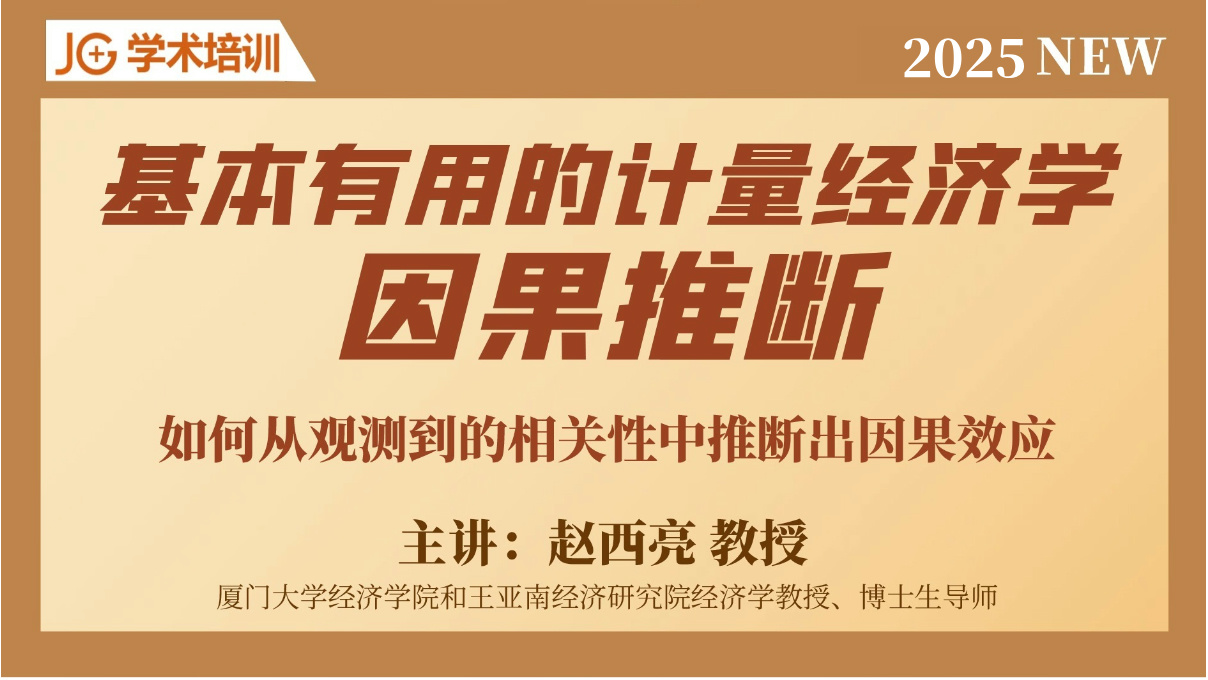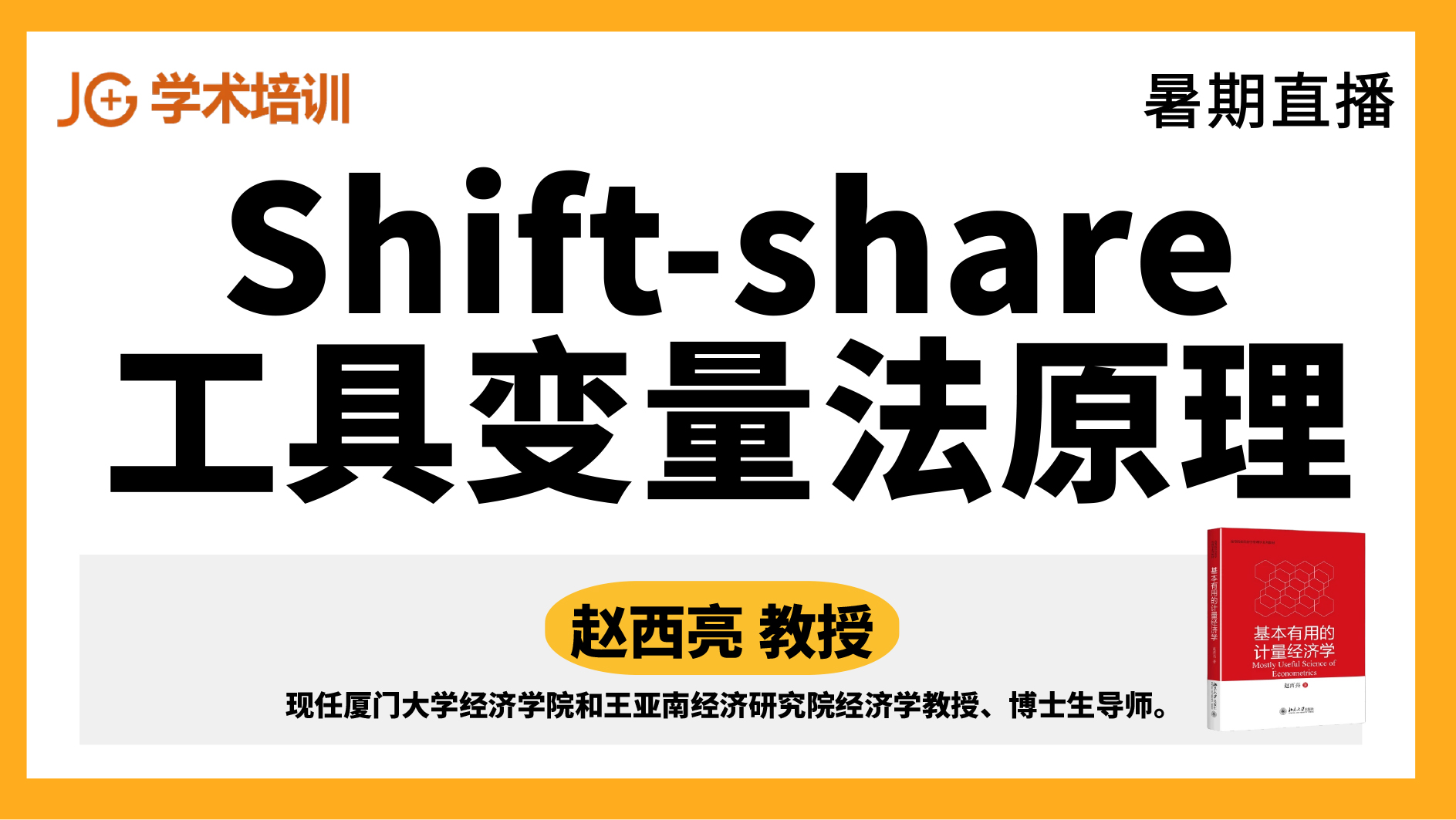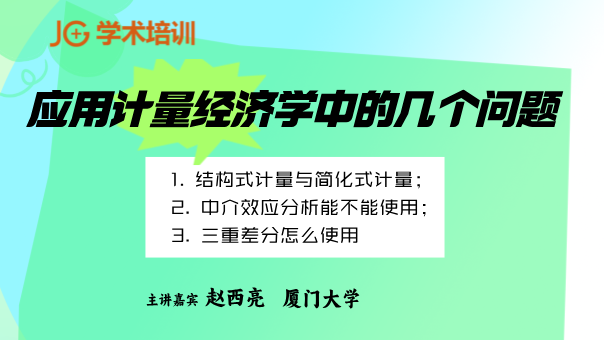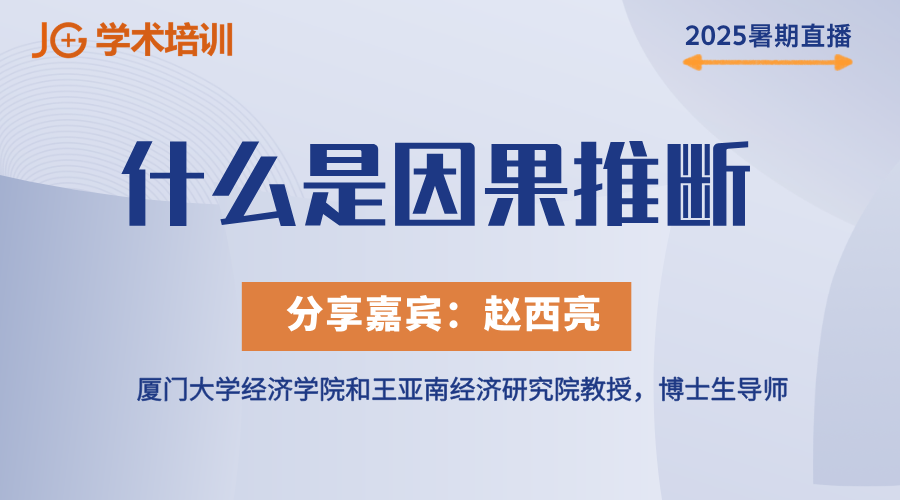上课信息
上课时间:
2025年8月14日-17日
上午 9:00-12:00;下午 14:00-17:00;答疑 17:00-17:30
上课地点: 成都现场+线上直播,提供配套资料和授课老师答疑
•线性回归、饱和模型、二元选择模型、方差估计
•带惩罚项的线性回归:偏差—方差权衡、交叉验证法、自助法(bootstrap)
•Lasso、岭回归、Neyman正交、Double Lasso
•RCM (Rubin Causal Model)
•潜在结果
•分配机制(treatment assignment)
•因果效应参数(causal estimand)
•因果识别
•回归和因果识别
• 三种基本结构
•后门标准
•混杂偏差和样本选择偏差
•什么是好的控制变量和坏的控制变量
•*前门标准
案例:
班级规模与学习成绩(Krueger, 1999),种族与就业歧视(Bertrand and Mullainathan, 2004)、竞选中名字在选票中的位置优势(Ho and Imai, 2006)、媒体的影响(Chen and Yang, 2019)
•随机化实验的作用
•随机化实验为什么是黄金标准?
•随机化实验的分析
•Design-based和sampling-based方差
•匹配、倾向指数匹配(PSM, Rosenbaum and Rubin, 1983; Abadie and Imbens, 2006)
•逆概率加权(Inverse probability weighting, IPW)
•回归调整(regression adjustment)
•双重稳健估计(double robust estimator)
案例:
培训的效果(Dehejia and Wahba, 1999)、
精英大学的作用(Dale and Kreuger, 2002)
•工具变量法的起源和基本思想
•工具变量法的基本识别条件
•如何选择工具变量,如何讨论工具变量的外生性条件?
•工具变量法的选择和说服审稿人的办法
•异质性因果效应下的工具变量法——LATE(Imbens and Angrist, 1994: Angrist, Imbens and Rubin, 1996)
•工具变量法和非依从的随机化实验(noncompliance RE)
•基于选择的工具变量法——Heckman两步法
•*未观测因素为基础的选择MTE——边际干预效应框架(Heckman and Vytlacil, 1999;2005)
案例:
出生季度和教育回报(Angrist and Krueger, 1991),
参军与收入(Angrist,1990)、家庭规模和父母劳动供给(Angrist and Lavy, 1998)、
美国的教育回报(Carneiro et al., 2011)、
全民儿童照护服务的收益(Cornelissen, Dustmann and Schonbrg, 2018)。
•随机效应模型
•固定效应模型
•Hausman检验
•固定效应是什么
•组内回归(within regression)和虚拟变量回归(LSDV)
•Stata命令reg、xtreg、areg、reghdfe的关系
案例:双胞胎数据估计中国教育回报(Li, Liu and Zhang, 2012)
•共同/平行趋势假设(Parallel/Common Trend Assumption)、无预期假设(no anticipation assumption)、无溢出效应假设(no spillover effects assumption)、共同区间假设(overlap assumption)
•经典DID的因果识别
•经典DID的参数估计:回归方法、PSM-DID(Heckman et al. 1997, 1998)、逆概率加权估计量(Abadie, 2005)、双重稳健估计量(Sant’Anna and Zhao, 2020)
•如何在回归模型中引入不时变的协变量Xi和时变协变量Xit?
案列:
移民冲击和工资(Card, 1990)、最低工资调整和就业(Card and Krueger, 1994)、
911事件对美国办公楼的影响(Abadie and Dermisi, 2008)、大学扩招和大学生失业(邢春冰和李实,2011)。
•基本识别条件:平行趋势假设、无预期假设和无溢出效应假设的重新表述。
•平行趋势假设检验和动态模型构造(事件研究法设计)
•以个体出生年份(cohort)构成的DID,有时也称为cohort DID,并不是一种新的设计
案例:
茶叶价格和消失的女性(Qian, 2008)、土豆和人口及城市化(Nunn and Qian, 2011)。
•DID和IV的结合:不满足平行趋势时的新设计
•基本识别条件、因果识别过程
•三重差分法(DDD):一种特殊的工具变量法
•基本识别条件、因果识别过程
案例:
印尼建校项目对教育回报的影响(Duflo, 2001)
强制福利对劳动力市场的影响(Gruber, 1994)
•基本识别条件的讨论
•TWFE估计量在估计什么(Goodman-Bacon, 2021; de Chaisemartin and D'Haultfoeuille, 2020)
Goodman-Bacon分解
•事件研究法存在的偏差(Sun and Abraham, 2021)
•如果正确的估计因果效应:
Callaway and Santa’Anna(2021)非参数估计量
Wooldridge(2021)回归估计量
案例:大而坏的银行:放松管制与收入分配(Beck et al., 2010; Baker et al., 2022)
•缺失值填补(Borusyak et al., 2021; Liu et al., 2021)
•合成控制法(Abadie et al., 2010)
•合成双重差分法(Arkhangelsky et al., 2021)
•广义合成控制法(Xu, 2017)
案例:加州控烟法案的效果(Abadie et al., 2010)
德国统一的经济影响(Abadie et al., 2015)
•精确断点回归设计:局部随机化假设、连续性假设
•模糊断点回归设计:工具变量法
•弯折断点回归设计:导数上的断点
案例:美国政党的在位优势(Lee,2008)、
空气污染和寿命(Chen et al., 2013;Ebenstein et al., 2017)、
学区房的价值(Black, 1999)、户口的价值(Chen et al., 2019)。
• 传统中介分析理论
• 自然间接效应(中介效应)、自然直接效应、控制直接效应
• 因果中介效应的基本识别条件:序贯可忽略性
• 工具变量因果中介模型
案例:教育通过职业影响收入的因果中介分析
| 报名时间 | 2025-05-13 10:42 至 2025-08-13 10:42 |
|---|---|
| 培训时间 | 2025年8月14日-17日 |
| 培训地点 | 成都现场+线上直播,提供配套资料和授课老师答疑 |
| 培训费用 | 5000元/ 4400元(学生优惠价仅限全日制本科及硕士在读) |
| 授课安排 | 上午 9:00-12:00;下午 14:00-17:00;答疑 17:00-17:30 |
当因果推断遇见DDML和DeepSeek-
基于设计的计量经济学
2025年8月
探讨因果关系是经济学实证研究的主要目的,因果关系一般是无法观测到的,我们只能观测到相关性,如何从观测到的相关性中推断出因果效应,是这门课中的主要内容。
计量经济学包括两块内容:统计推断(参数估计和假设检验)和因果推断。然而,现在有很多人搞不清楚两者的区别,在进行实证研究的时候,不知道参数识别(统计推断)和因果识别(因果推断)的区别,两块内容混淆在一起,就无法把相关性参数和因果性参数区别开来。
现有很多计量教材集中于统计推断,对因果推断很少涉及,包括安神(Angrist and Pischke, 2009)的《基本无害的计量经济学》也没有显性的讲出来什么是因果识别,如何构造识别策略。本课程将详细的对此进行区分,明确目标参数、识别策略和估计方法(OLS,MLE,GMM)的区别。
不讲潜在结果框架或Rubin因果模型(RCM),就无法说清楚因果识别;不讲图因果模型或Pearl因果模型(PCM),就无法清楚的构建因果识别策略。不讲随机化实验,就无法讲解清楚实证中的因果效应估计。
课程目的:
让学员明确经济学实证研究的基本步骤:首先,定义清楚目标参数(causal estimand),其次,构造识别策略,建立统计参数(statistical estimand),最后,构造估计量(estimator),得到目标参数的估计值。由目标参数到统计参数,由观测不到的因果效应转变化可以观测到的统计参数的过程,即因果推断。利用样本信息构造估计量,估计统计参数,即统计推断。
2025 内容更新:
• 增加高维协变量(解释变量个数多于样本量情形)下的统计推断和因果推断方法,主要是MIT教授Chernozhukov等人发展的理论,包括双重Lasso和双重机器学习(Double Lasso/Double ML)。
• 增加平行趋势假设检验方法及平行趋势假设不满足时的敏感性分析方法
• 增加因果中介分析的理论和应用介绍
• 增加deepseek/Grok + Stata数据处理,借助最新人工智能大模型,为科研助力
讲师介绍:
赵西亮,现任厦门大学经济学院和王亚南经济研究院经济学教授、博士生导师。
清华大学经济管理学院数量经济学专业博士,美国康奈尔大学和芝加哥大学访问学者,加拿大西安大略大学经济系博士后,长期从事中国经济和应用计量经济学研究,编著教材《基本有用的计量经济学》,被京东评为“十大构思细腻的大学教材”之一。
赵老师在《经济研究》、《经济学》(季刊)、《数量经济技术经济研究》、《World Economy》等国内外重要期刊发表论文数余篇,同时是ChinaEconomic Review, 《经济研究》、《管理世界》、《经济学(季刊)》、《世界经济》等国内外重要期刊的匿名审稿人。
课程特色:
l 《基本有用的计量经济学》(第2版)最新内容。
进行了全面更新,对统计推断和因果推断进行了区分,对因果推断和因果识别进行了明确定义,并将估计方法和因果推断区分开来,吸收了最近几年各类方法的最新发展,并在统一的框架内进行详细解构,让读者更容易掌握因果推断的基本内容。
l 对结构计量和简约计量进行区分,结果计量也称为基于模型的计量,简约计量主要指基于设计的计量,两种研究范式不同,目前学术界研究基于采用结构计量的思路,但却采用简约计量的做法,存在着一定矛盾,我们将讲清楚两者的区别,以及如何使用基于设计的计量。
l 讲清楚因果效应参数(causal estimands)、统计参数(statistical estimands)和统计量(estimators)的区别。实证分析的第一步就是明确自己想回答的问题,定义清楚因果效应参数或目标参数(target parameters),才能根据研究问题的背景信息和先验知识,构造识别策略。
l 因果推断的关键在于分配机制(assignment mechanism),识别策略主要是对分配机制的描述,通过引入合理的识别条件,描述可能的分配机制,才能识别出因果效应。理解了分配机制,也就理解了因果推断的核心内容,对于匹配、IV、DID(SC)、RDD等具体的方法也就更容易理解。
l 引入高维情形下的统计推断和因果推断,以适应大数据实证的需要。并引入因果中介理论的介绍,讨论如何使中介分析更加可信。
l 在实证分析中,原因变量(或核心解释变量)和控制变量的地位是不同的,如何才能合理的选择控制变量?控制变量越多越好吗?选择控制变量的基本原则是什么?
l 如何选择工具变量?如何思考工具变量的独立性和排除性假设?如何合理化(justify)你的工具变量?
l 面板数据中固定效应是什么,起着什么作用,如何加固定效应?
l 估计方法和目标参数之间是什么关系,关于交错DID(staggered DID)的最新发展,充分反映了这一矛盾。OLS、TSLS、TWFE作为经济学家常用的估计方法,很多时候并不能给研究者想要的目标参数,并不能回答作者想回答的问题。如何解决?
l 结合案例讲解各种方面的Stata软件实现,并结合最新人工智能大模型deepseek/Grok,介绍利用AI大模型助力Stata数据编程和学术研究。
本课程学员可以学到:
• 统计推断的基本内容,线性回归只是一种参数估计方法,MLE/GMM也是参数估计方法?
• 为什么要考虑高维情形下的参数估计、变量选择方法?
• OLS在估计什么?和因果效应参数是什么关系?
• 什么是因果识别?因果识别和参数识别的区别?
• 如何进行因果推断,如何引入识别条件?
• 如何选择控制变量,基本的原则是什么?
• 什么是固定效应,如何加固定效应?
• 如果选择工具变量,如何说明工具变量的有效性,应该如何思考独立性和排除性假设?
• 如何利用自然实验,包括工具变量、双重差分、断点回归,来识别因果效应?
• 在多期交错政策(staggered)下,双向固定效应方法(TWFE)在估计什么,Goodman-Bacon分解如何判断TWFE估计量的合理性。
• 在交错政策下,事件研究法为何不能用,如果运用正确的方法,包括Callaway and Sant’Anna (2021)的非参数估计量和Wooldridge(2021)的回归估计量。
• 如果进行因果中介分析?
课程大纲:
第1讲 统计推断
• 线性回归、饱和模型、二元选择模型、方差估计
• 带惩罚项的线性回归:偏差—方差权衡、交叉验证法、自助法(bootstrap)
• Lasso、岭回归、Neyman正交、Double Lasso
第2讲 潜在结果框架
• RCM(Rubin Causal Model)
• 潜在结果
• 分配机制(treatment assignment)
• 因果效应参数(causal estimand)
• 因果识别
• 回归和因果识别
第3讲 因果图
• 三种基本结构
• 后门标准
• 混杂偏差和样本选择偏差
• 什么是好的控制变量和坏的控制变量
• *前门标准
第4讲 随机化实验
• 随机化实验的作用
• 随机化实验为什么是黄金标准?
• 随机化实验的分析
• Design-based和sampling-based方差
案例:
班级规模与学习成绩(Krueger,1999),种族与就业歧视(Bertrand and Mullainathan, 2004)、竞选中名字在选票中的位置优势(Ho and Imai, 2006)、媒体的影响(Chen and Yang,2019)
第5讲 非混杂性条件下的因果效应估计
最基本的识别条件是非混杂性(unconfoundedness),也称为条件独立性假设(CIA, Angristand Pischke 2009),或根据观测变量进行的选择(selection on theobservables)或可忽略性(ignorablity),是最基础的分配机制。这类策略的关键是通过(匹配)设计,模拟随机化实验。
• 匹配、倾向指数匹配(PSM, Rosenbaum and Rubin, 1983; Abadie and Imbens, 2006)
• 逆概率加权(Inverse probability weighting, IPW)
• 回归调整(regression adjustment)
• 双重稳健估计(double robust estimator)
• 双重机器学习(double/debiased machine learning)
案例:
培训的效果(Dehejiaand Wahba, 1999)、精英大学的作用(Dale and Kreuger, 2002)
第6讲 工具变量法
工具变量法在模拟非依从的随机化实验。
• 工具变量法的起源和基本思想
• 工具变量法的基本识别条件
• 如何选择工具变量,如何讨论工具变量的外生性条件?
• 工具变量法的选择和说服审稿人的办法
• 异质性因果效应下的工具变量法——LATE(Imbens and Angrist, 1994: Angrist, Imbens and Rubin, 1996)
• 工具变量法和非依从的随机化实验(noncompliance RE)
• 基于选择的工具变量法——Heckman两步法
• *未观测因素为基础的选择MTE——边际干预效应框架(Heckman and Vytlacil, 1999;2005)
案例:
出生季度和教育回报(Angristand Krueger, 1991),参军与收入(Angrist,1990)、家庭规模和父母劳动供给(Angrist and Lavy, 1998)、美国的教育回报(Carneiro etal., 2011)、全民儿童照护服务的收益(Cornelissen, Dustmann andSchonbrg, 2018)。
第7讲 固定效应方法
• 随机效应模型
• 固定效应模型
• Hausman检验
• 固定效应是什么
• 组内回归(within regression)和虚拟变量回归(LSDV)
• Stata命令reg、xtreg、areg、reghdfe的关系
案例:
双胞胎数据估计中国教育回报(Li, Liu and Zhang, 2012)
第8讲 经典双重差分法
双重差分法在模拟增量上的随机化实验,在线性假设下,属于固定效应模型。
• 共同/平行趋势假设(Parallel/Common Trend Assumption)、无预期假设(no anticipation assumption)、无溢出效应假设(nospillover effects assumption)、共同区间假设(overlapassumption)
• 经典DID的因果识别
• 经典DID的参数估计:回归方法、PSM-DID(Heckman et al. 1997, 1998)、逆概率加权估计量(Abadie,2005)、双重稳健估计量(Sant’Anna and Zhao, 2020)
• 如何在回归模型中引入不时变的协变量Xi和时变协变量Xit?
案列:
移民冲击和工资(Card,1990)、最低工资调整和就业(Card and Krueger, 1994)、911事件对美国办公楼的影响(Abadie and Dermisi, 2008)、大学扩招和大学生失业(邢春冰和李实,2011)。
第9 讲 多期单一政策DID
经典DID的扩展,扩展到多期,仍然只有一个干预组和一个控制组
• 基本识别条件:平行趋势假设、无预期假设和无溢出效应假设的重新表述。
• 平行趋势假设检验和动态模型构造(事件研究法设计)
• 平行趋势检验方法和敏感性分析
• 以个体出生年份(cohort)构成的DID,有时也称为cohortDID,并不是一种新的设计
案例:
茶叶价格和消失的女性(Qian,2008)、土豆和人口及城市化(Nunn and Qian, 2011)。
第10 讲 DID-IV设计
• DID和IV的结合:不满足平行趋势时的新设计
• 基本识别条件、因果识别过程
• 三重差分法(DDD):一种特殊的工具变量法
• 基本识别条件、因果识别过程
案例:
印尼建校项目对教育回报的影响(Duflo, 2001)、强制福利对劳动力市场的影响(Gruber, 1994)。
第11讲 交错DID(staggered DID)
个体是逐渐受到政策影响的,不再只有单纯的干预组和控制组两组,而是有很多的干预组和控制组,而干预组被干预的时点不同,用这样的数据估计政策影响时,早期文献仍然沿用第10讲多期单一政策时的设计方法,采用双向固定效应模型(TWFE)估计,但最新的文献发现,在交错政策时,如果存在组间异质性(Goodman-Bacon, 2021)和时间上异质性(Sun andAbraham, 2021)时,TWFE估计量存在着偏差,事件研究法存在着污染偏差(Contamination bias)。
• 基本识别条件的讨论
• TWFE估计量在估计什么(Goodman-Bacon,2021; de Chaisemartin and D'Haultfoeuille, 2020)
Ø Goodman-Bacon分解
• 事件研究法存在的偏差(Sun and Abraham, 2021)
• 如果正确的估计因果效应:
Ø Callaway and Santa’Anna(2021)非参数估计量
Ø Wooldridge(2021)回归估计量
案例:
大而坏的银行:放松管制与收入分配(Beck et al., 2010; Baker et al., 2022)
第12讲缺失值填补方法
• 缺失值填补(Borusyak et al., 2021; Liu et al., 2021)
• 合成控制法(Abadie et al., 2010)
• 合成双重差分法(Arkhangelsky et al., 2021)
• 广义合成控制法(Xu, 2017)
案例:
加州控烟法案的效果(Abadieet al., 2010);德国统一的经济影响(Abadie et al., 2015)
第13讲 断点回归设计
最接近于完全随机化实验的研究设计,教育学家发明(Thistlethwaite and Compbell, 1960),作者认为价值不大,但被经济学家挖掘出来,焕发异彩(Hahn et al. 2001)。本章讨论RDD、Fuzzy RDD、Kink RDD的基本识别条件、估计方法、带宽选择方法等。
• 精确断点回归设计:局部随机化假设、连续性假设
• 模糊断点回归设计:工具变量法
• 弯折断点回归设计:导数上的断点
案例:
美国政党的在位优势(Lee,2008);空气污染和寿命(Chen et al., 2013;Ebenstein et al., 2017);学区房的价值(Black, 1999);户口的价值(Chen et al., 2019)。
第14讲因果中介分析
• 传统中介分析理论
• 自然间接效应(中介效应)、自然直接效应、控制直接效应
• 因果中介效应的基本识别条件:序贯可忽略性
• 工具变量因果中介模型
案例:
教育通过职业影响收入的因果中介分析
优惠信息:
现场班老学员9折优惠;
同一单位三人以上同时报名9折优惠;
以上优惠与学生优惠价不叠加。
报名咨询:
电话:18600257362
QQ:3196394371
微信:jgzjwanzi

加微信请备注:因果推断
参考文献:
[1] Abadie,A. (2005), "Semiparametric Difference-in-Differences Estimators,"Review of Economic Studies, vol. 72, 1-19.
[2] Abadie,A., A. Diamond and J. Hainmueller (2010), "Synthetic Control Methods forComparative Case Studies: Estimating the Effect of California's Tobacco ControlProgram," Journal of the American Statistical Association, vol. 105,493-505.
[3] Abadie,A., A. Diamond and J. Hainmueller (2015), “Comparative Politics and theSynthetic Control Method”, American Journal of Political Science.
[4] Abadie, Alberto, andGuido W. Imbens. "Large sample properties of matching estimators foraverage treatment effects." econometrica 74.1 (2006): 235-267.
[5] Abadie, A. and S. Dermisi (2008), "IsTerrorism Eroding Agglomeration Economies in Central Business Districts?Lessons from the Office Real Estate Market in Downtown Chicago," Journalof Urban Economics, vol. 64,451-463.
[6] Angrist, Joshua D."Lifetime earnings and the Vietnam era draft lottery: evidence from socialsecurity administrative records." The american economic review(1990): 313-336.
[7] Angrist, Joshua D.,and William N. Evans. "Children and Their Parents' Labor Supply: Evidencefrom Exogenous Variation in Family Size." American Economic Review(1998): 450-477.
[8] Angrist,J., G. Imbens, and D. Rubin, "Identification of Causal effects UsingInstrumental Variables," with comments and rejoinder, JASA, 1996.
[9] Arkhangelsky, Dmitry, et al. "Syntheticdifference-in-differences." American Economic Review 111.12 (2021):4088-4118.
[10] Baker, Andrew C., David F. Larcker, and Charles CY Wang."How much should we trust staggered difference-in-differencesestimates?." Journal of Financial Economics 144.2 (2022): 370-395.
[11] Beck,Thorsten, Ross Levine, and Alexey Levkov. "Big bad banks? The winners andlosers from bank deregulation in the United States." The Journal ofFinance 65.5 (2010): 1637-1667.
[12] Belloni,Alexandre, Victor Chernozhukov, and Christian Hansen. "Inference ontreatment effects after selection among high-dimensionalcontrols." Review of Economic Studies 81.2 (2014): 608-650.
[13] Bertrand,Marianne, and Sendhil Mullainathan (2004), “Are Emily and Greg More employablethan Lakisha and Jamal? A field experiment on labor market discrimination”,AER, 94(4): 991-1013.
[14] Black,Sandra E. (1999), “Do better schools matter? Parental valuation of elementaryeducation”, QJE, 114(2): 577-99.
[15] Borusyak, Kirill, Xavier Jaravel, and Jann Spiess."Revisiting event study designs: Robust and efficient estimation." arXivpreprint arXiv:2108.12419 (2021).
[16] Callaway, Brantly and Pedro H. C.Sant’Anna. 2021. "Difference-in-Differences with Multiple TimePeriods." Journal of Econometrics, 225(2), 200-30.
[17] Card, David. "The impact of the Mariel boatlift onthe Miami labor market." Ilr Review 43.2 (1990): 245-257.
[18] Card,D. and A.B. Krueger (1994), "Minimum Wages and Employment: A Case Study ofthe Fast-Food Industry in New Jersey and Pennsylvania," American EconomicReview, vol. 84, 772-793.
[19] Carneiro, Pedro, James J. Heckman, and Edward J.Vytlacil. "Estimating marginal returns to education." AmericanEconomic Review 101.6 (2011): 2754-2781.
[20] Chen,Yuyu, Avraham Ebenstein, Michael Greenstone, and Hongbin Li (2013) “Evidence onthe impact of sustained exposure to air pollution on life expectancy fromChina’s Huai river policy”, PNAS, 110(2):12936-41.
[21] Chen, Yu; Shaobin Shi andYugang Tang. 2019. "Valuingthe Urban Hukou in China: Evidence from a Regression Discontinuity Design forHousing Prices." Journal of Development Economics, 141, 102381.
[22] Chen, Yuyu, and David Y. Yang. 2019. "TheImpact of Media Censorship: 1984 or Brave New World?" American Economic Review, 109(6): 2294-2332.
[23] Victor Chernozhukov, Denis Chetverikov, MertDemirer, Esther Duflo, Christian Hansen, Whitney Newey, James Robins,Double/debiased machine learning for treatment and structural parameters, The Econometrics Journal, Volume 21, Issue 1, 1February 2018, Pages C1–C68, https://doi.org/10.1111/ectj.12097
[24] Cornelissen,Thomas, Christian Dustmann, Anna Raute, and Uta Schönberg, "Who Benefitsfrom Universal Child Care? Estimating Marginal Returns to Early Child CareAttendance," Journal of Political Economy 126, no. 6 (December 2018):2356-2409.
[25] Dale,Stacy Berg, and Alan B. Krueger,Estimatingthe Payoff to Attending a More Selective College: An Application of Selectionon Observables and Unobservables, The Quarterly Journal of Economics,Volume 117, Issue 4, November 2002, Pages 1491–1527, https://doi.org/10.1162/003355302320935089
[26] De Chaisemartin, Clément, and Xavier d’Haultfoeuille."Two-way fixed effects estimators with heterogeneous treatmenteffects." American Economic Review 110.9 (2020): 2964-2996.
[27] Dehejia,R.H. and S. Wahba (1999), "Causal Effects in Non-Experimental Studies:Re-Evaluating the Evaluation of Training Programs," Journal of theAmerican Statistical Association, vol. 94, 1053-1062.
[28] Duflo,E. (2001), "Schooling and Labor Market Consequences of School Constructionin Indonesia: Evidence from an Unusual Policy Experiment," AmericanEconomic Review, vol. 91, 795-813.
[29] Ebenstein, Avraham, et al. "New evidence on theimpact of sustained exposure to air pollution on life expectancy from China’sHuai River Policy." Proceedings of the National Academy of Sciences114.39 (2017): 10384-10389.
[30] Goodman-Bacon, Andrew. 2021."Difference-in-Differences with Variation in Treatment Timing." Journalof Econometrics, 225(2), 254-77.
[31] Gruber, Jonathan. "The incidence of mandatedmaternity benefits." The American economic review (1994): 622-641.
[32] Hahn,J., P. Todd, and W. van der Klaauw, "Identification and Estimation ofTreatment Effects with a Regression-Discontinuity Design, Econometrica 69(2001), 201-209.
[33] Heckman,J.J., H. Ichimura and P.E. Todd (1997), "Matching as an EconometricEvaluation Estimator: Evidence from Evaluating a Job Training Programme,"Review of Economic Studies, vol. 64, 605-654.
[34] Heckman, James J., Hidehiko Ichimura, and Petra Todd."Matching as an econometric evaluation estimator." The review ofeconomic studies 65.2 (1998): 261-294.
[35] Heckman,J. James and Edward J. Vytlacil (1999) Local Instrumental Variables and LatentVariable Models for Identifying and Bounding Treatment Effects, Proc. Natl.Acad. Sci. USA, 96: 4730-4734.
[36] Heckman,J. James and Edward Vytlacil (2005) Structural Equations, Treatment Effects,and Econometric Policy Evaluation, Econometrica, 73(3): 669-738.
[37] Ho,Daniel E & Kosuke Imai (2006) Randomization Inference with NaturalExperiments, Journal of the American Statistical Association, 101:475, 888-900,DOI: 10.1198/016214505000001258
[38] KosukeImai. Luke Keele. Teppei Yamamoto. "Identification,Inference and Sensitivity Analysis for Causal MediationEffects." Statist. Sci. 25 (1) 51 - 71, February2010. https://doi.org/10.1214/10-STS321
[39] Imbens,G and J. Angrist, "Identification and Estimation of Local AverageTreatment Effects," Econometrica, March 1994.
[40] Krueger,A. (1999), "Experimental Estimates of Education ProductionFunctions," Quarterly Journal of Economics, 114(2): 497-532.
[41] Lee,D., "Randomized Experiments from Non-Random Selection in U.S. HouseElections," Journal of Econometrics 142, 2008.
[42] Li, Hongbin, Pak Wai Liu, and Junsen Zhang."Estimating returns to education using twins in urban China." Journalof Development Economics 97.2 (2012): 494-504.
[43] Liu, Licheng, Ye Wang, and Yiqing Xu. "A PracticalGuide to Counterfactual Estimators for Causal Inference with Time‐SeriesCross‐Sectional Data." American Journal of Political Science(2022).
[44] NancyQian. 2008. Missing Women and the Price of Tea in China: The Effect ofSex-Specific Earnings on Sex Imbalance. Quarterly Journal of Economics,Vol.123, No.3, pp.1251-1285.
[45] Nunn,Nathan and Nancy Qian, (2011), The Potato’s Contribution to Population andUrbanization: Evidence from A Historical Experiment, QJE, 1-53.
[46] Rambachan, A., & Roth, J. (2023). A morecredible approach to parallel trends. Review of Economic Studies, 90(5),2555-2591.
[47] Rosenbaum, Paul R., and Donald B. Rubin. "Thecentral role of the propensity score in observational studies for causaleffects." Biometrika 70.1 (1983): 41-55.
[48] Roth, J. (2022). Pretest with caution:Event-study estimates after testing for parallel trends. AmericanEconomic Review: Insights, 4(3), 305-322.
[49] Sant’Anna, Pedro HC, and Jun Zhao. "Doubly robustdifference-in-differences estimators." Journal of Econometrics219.1 (2020): 101-122.
[50] Sun, Liyang and Sarah Abraham.2021. "Estimating Dynamic Treatment Effects in Event Studies withHeterogeneous Treatment Effects." Journal of Econometrics, 225(2), 175-99.
[51] Thistlethwaite, Donald L., and Donald T. Campbell."Regression-discontinuity analysis: An alternative to the ex post factoexperiment." Journal of Educational psychology 51.6 (1960): 309.
[52] Wooldridge, Jeffrey M. "Two-way fixed effects, thetwo-way mundlak regression, and difference-in-differences estimators." Availableat SSRN 3906345 (2021).
[53] Xu, Yiqing. "Generalized synthetic control method:Causal inference with interactive fixed effects models." PoliticalAnalysis 25.1 (2017): 57-76.
[54] 赵西亮,因果中介分析的理论进展及其应用,《数量经济技术经济研究》,2025年第2期。
[55] 双重差分法原理及其最新发展:一个不完全综述 by Zhao Xiliang ::SSRN





内容不能少于5个字符!



 分享
分享 收藏
收藏





